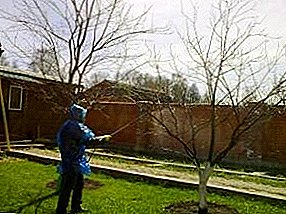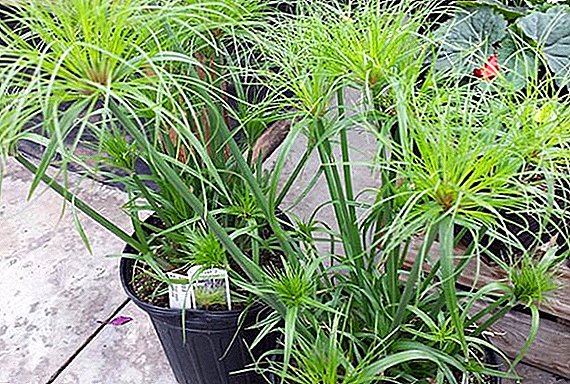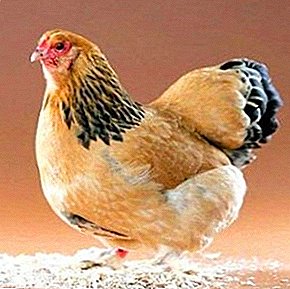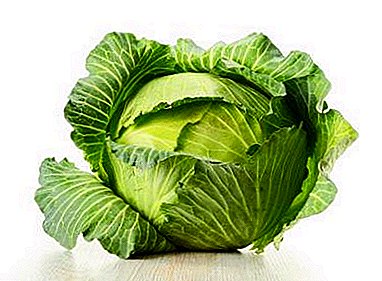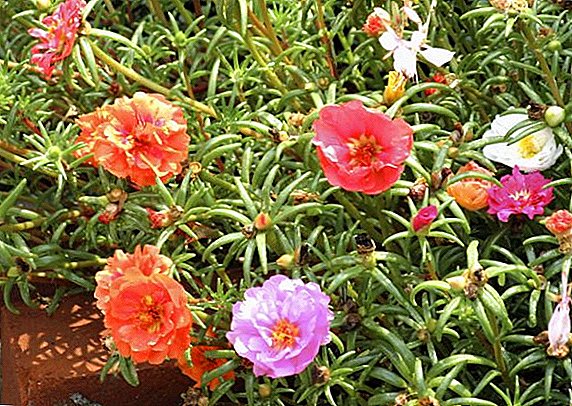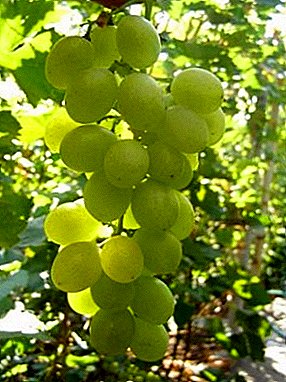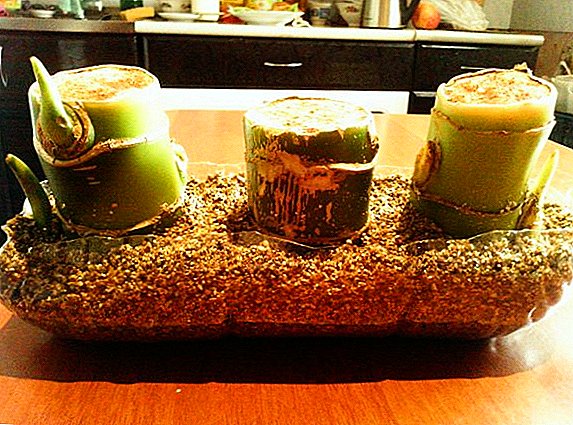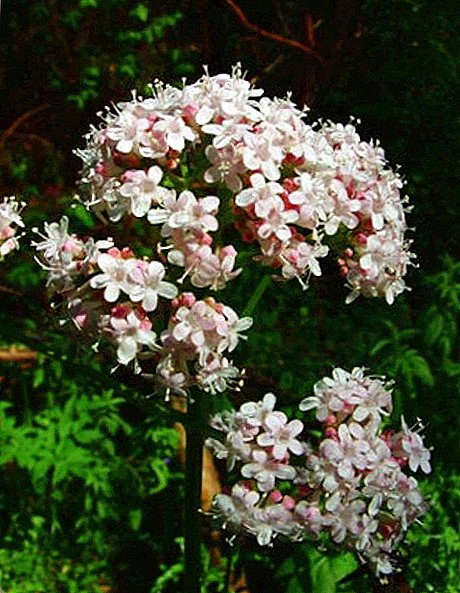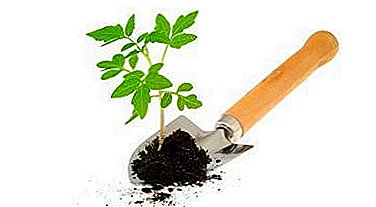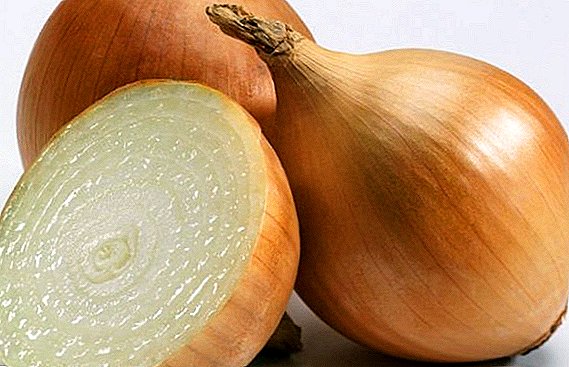 Onion is a versatile vegetable. Rarely what dish is prepared without this ingredient. And due to its healing properties, onions are widely used in traditional medicine. It is very popular, therefore it grows in almost all household farms and farmers' fields. Among the most popular varieties can be called onion variety "Cupido". Consider the features of its cultivation.
Onion is a versatile vegetable. Rarely what dish is prepared without this ingredient. And due to its healing properties, onions are widely used in traditional medicine. It is very popular, therefore it grows in almost all household farms and farmers' fields. Among the most popular varieties can be called onion variety "Cupido". Consider the features of its cultivation.
Variety description
Cupido F1 is an onion hybrid of Dutch origin. This is a medium early high-yielding variety of onions. It forms a dense bulb of a large size with a thin neck. Weight is 110-130 g. The shape is round, slightly elongated. The skin is double, thin, but elastic, tight to the head, which contributes to long-term storage. The husk has a light yellow, straw color. The plant forms a strong root system.
Feathers grow up to 30 cm in height, arrows are extremely rare. The taste of the bulb is soft, semi-sharp. The use of the vegetable is universal: it harmonizes well in fresh salads with other vegetables, and is also suitable for boiled dishes, stewing and roasting.  The advantages of the variety:
The advantages of the variety:
- high yield;
- early ripening;
- pleasant taste;
- arrows are not formed;
- resistance to pests and diseases;
- good storage and long-term storage;
- unpretentious care;
- suitable for both spring and autumn planting;
We advise you to get acquainted with the peculiarities of the cultivation of other varieties of onion: "Exhibition", "Sturon", "Setton", "Shetana", "Red Baron".
Characteristics of onions and yield
Cupido F1 refers to the early varieties. From the emergence of shoots to the full maturation of the bulbs can take 75-85 days. If planting is carried out in the fall, the harvest can be collected in May.
Reviews gardeners about yield Cupido only positive:
- maturation almost 100%;
- the mass of one bulb to 130 g;
- the harvest from one weave can be 350-400 kg.
Selection of planting material
 The quality of planting for planting can be determined by its appearance. He must:
The quality of planting for planting can be determined by its appearance. He must:
- be dry and rustling;
- be tight to the touch;
- have a oblong shape and a thin neck;
- be light golden in color.
Sevok should not:
- have traces of mold and rot;
- smell unpleasantly;
- have a shape and color that does not match the variety;
- be too big.
Important! The size of planting sevka is directly related to the quality of the crop: the larger the bulb, the greater the likelihood that it will shoot the arrow.When buying Cupido seeds, it is important to look at the date when they were packed. It is best to ascend Nigella collected last year.
Growing conditions
Cupido is picky and not too picky about environmental conditions, but he still has his own preferences. He likes to grow in areas open to the sun's rays, but closed from strong winds.  Dutch onion is afraid of the cold. Sudden changes in temperature from "minus" to "plus" can trigger the formation of arrows, or even destroy the plant. Therefore, sevka should be planted when there is no danger of frost: in the fall - three weeks before the onset of cold weather, and in the spring - when the positive temperature is already stable.
Dutch onion is afraid of the cold. Sudden changes in temperature from "minus" to "plus" can trigger the formation of arrows, or even destroy the plant. Therefore, sevka should be planted when there is no danger of frost: in the fall - three weeks before the onset of cold weather, and in the spring - when the positive temperature is already stable.
Variety "Cupido" loves moderate humidity. Too wet or dry land is not to his taste. Therefore, it is desirable to water it as the land dries.
Soil and fertilizer
Cupido will grow on any soil, but prefers a nutritious, fertile land with neutral acidity. Also, it should be loose and well pass moisture. Therefore, the best option would be sandy or loamy soil. It is fertilized with organic matter: compost, humus or rotted chicken droppings.
To get a good harvest you need to follow the rules of crop rotation. Onions do not like weeds, so it is better to plant them after those plants, after which weeds do not grow well. Such crops include cucumbers, zucchini, squash, peppers, tomatoes, potatoes, cabbage, winter cereals and legumes.  Experienced gardeners prudently plant around onion beds of plants that frighten off the main pest - the onion fly. For such protection, sow carrots, marigolds or calendula.
Experienced gardeners prudently plant around onion beds of plants that frighten off the main pest - the onion fly. For such protection, sow carrots, marigolds or calendula.
We recommend to get acquainted with the table of vegetable crop precursors during planting.
Growing from seed to seedlings at home
Cupido, like other onion varieties, is a biennial plant. In the first year, seeds are grown from seeds, from which large heads grow in the second year. Although many experts manage to grow full-fledged bulbs in one year. To do this, in the winter they sow chernushka in boxes, and the resulting sevok plant in the spring already in open ground.
Seed preparation
Seed preparation for sowing takes place in two stages:
- Check the quality of seeds. For this purpose, they are immersed in a saline solution, in which empty seeds float, and full-weighted ones sink to the bottom. Sowing quality nippers increases the germination rate.
- Disinfection: good seeds are immersed in potassium permanganate solution for treatment against pathogens and pests. After soaking the niece you need to dry.

Important! Certified seeds purchased at a specialty store do not need preparation. They have already been tested and decontaminated.
Content and location
There are several methods for planting onion seeds:
- in open ground they plant both in the fall (one month before the onset of cold weather) and in the spring, when a stable positive temperature is established;
- in a greenhouse or under film: this will protect crops from sudden changes in temperature;
- in a room where the room temperature is maintained, the chernushka is sown in a snail (moistened cotton cloth twisted by a snail), in cups, a container or box filled with fertilized soil.
Seed planting process
Place for planting, soil and seeds prepared in advance. Sowing is as follows:
- In the tank with a wet ground, you need to make grooves, shallow and narrow: 1.5-2 cm by 5 cm.
- In the grooves done densely sow the seeds.
- Top sprinkled with moist earth.
 When planting Chernushka in the open area, the same technology is observed. Between the beds you need to make a distance sufficient for weeding and loosening. Autumn planting in the garden should be covered with straw or dry leaves for insulation.
When planting Chernushka in the open area, the same technology is observed. Between the beds you need to make a distance sufficient for weeding and loosening. Autumn planting in the garden should be covered with straw or dry leaves for insulation.
Seedling care
Care is watering, weeding and loosening. Do not water the "Cupido" often, he does not like it. Watering is carried out as the soil dries. Every time after watering, it is necessary to loosen the ground, giving the opportunity for the seedlings to "breathe." On open beds it is necessary to weed the weeds so that they do not score the shoots of the onions. It is not necessary to feed the seedlings, enough fertilizer that was made before sowing the seeds.
Seedlings grown indoors should be hardened before planting in open ground. A week before transplantation, a sowing box should be taken out daily in a cool place, for example, on a balcony. Stay in cool can be increased every day for a few minutes. Seasoned seedlings will get used to the cold and will be able to survive the sudden frosts. 
Transplanting seedlings to ground
Terms of planting seedlings in the ground depend on the weather. The best time for this comes when the warm spring weather is stably holding out without the threat of frost. The earth must have time to warm up.
The site for onion planting must be prepared in advance. To do this, it must be dug up, cleaned of weeds and fertilized with organic fertilizer, for example, with humus.
Such types of onions are grown in the open field: chives, shallots, leeks, slizun, batun.
Seeding is transplanted as follows:
- Shallow furrows (5 cm deep) are pulled out on the prepared site.
- Trenches are made at a distance of 20 cm from each other.
- Onions are planted at a sufficient distance so as not to interfere with each other (not less than 10 cm).
- The beds are filled with wet soil.
Cultivation from sevka in open ground
Growing onion Cupido from the sevka is very simple. At the same time, the yield is almost 100%. If you follow a few simple rules when planting a seeding and caring for it, it will give excellent results.
Site selection and soil preparation
Cupido bow is unpretentious, so sevok usually sown in open ground. But if weather forecasters predict late and cold spring, then it is possible to build a greenhouse for onions, since it is afraid of cold weather. Planting for the winter can also be covered with a film so that the seams are not frozen and guaranteed to yield. But most often the onions are planted in a greenhouse to produce greenery in early spring or late autumn.  The bow of this hybrid variety loves a lot of sun and a lot of air, and at the same time it needs protection from strong wind. Therefore, the landing site can be prepared near the southern wall of the house, which will protect the landing from the weather. Also, according to the rules of crop rotation, it is desirable that melon, sucker or bean crops should grow on this site earlier. The soil should be loose and nutritious.
The bow of this hybrid variety loves a lot of sun and a lot of air, and at the same time it needs protection from strong wind. Therefore, the landing site can be prepared near the southern wall of the house, which will protect the landing from the weather. Also, according to the rules of crop rotation, it is desirable that melon, sucker or bean crops should grow on this site earlier. The soil should be loose and nutritious.
To prepare a place for Cupido, you need to clear it in advance of weeds, dig up or loosen. It is also necessary to apply fertilizer, preferably organic.
Seed preparation
For planting it is better to choose a small set (1 cm in diameter), it will not have arrows. Larger bulbs can be planted on the greens. Seed preparation can be divided into three stages:
- Drying and warming of the set at a temperature of 30-35 ° C for 1-2 weeks. This is especially important for purchased planting material that was stored under unknown circumstances. So you can save bulbs from bolting.
- Disinfection in a solution of potassium permanganate or copper sulfate to protect against diseases and insects.
- Processing set growth stimulants. You can use for this purchase. And you can prepare a solution of wood ash, which disinfects the onion and will support them with essential vitamins and minerals.
VIDEO: TECHNOLOGY OF CROPPED LUKA-SEVKA
The process of planting sevka in the ground
The process of planting purchased seed is the same as when planting seedlings grown from seeds in the ground:
- Planting pattern: 10 cm between the bulbs and 20 cm between the rows.
- Sowing onions are pressed into the ground to a depth of 3-5 cm.
- Sevka covered with earth, leaving tails on the surface.
Watering
Watering onion beds is often not necessary: the bulbs can rot or get sick. Watering is necessary as needed, or rather, as the drying of the soil. Onion Cupido can tolerate drought. But do not delay with watering for more than three weeks.
Soil loosening and weeding
Necessary elements of care for onion plantings are loosening and weeding. Cupido does not tolerate weeds, as they impede the normal growth of the crop. Therefore, weed grass must be fought as soon as it appears next to the onion. And loosening should be done after each watering. This is the only way to ensure the access of moisture and air to the underground part of the plant. 
Top dressing
If the soil is fertile, it is enough to fertilize it before planting onions. If there is not enough nutrients in the soil, it is advisable to feed it, but before the bulbs are formed. During the growth of greenery it is desirable to make fertilizers containing nitrogen, which is necessary for the formation of feathers. No need to do this, if the expected harvest of onions.
Pests, diseases and prevention
The variety "Cupido" is resistant to diseases and most insects. The only threat to it is the onion fly. Onion fly In order to protect the onion plantations from it, experienced gardeners advise to spray feathers with special means for disinsection. Some also plant a number of onion plants that scare this pest.
Onion fly In order to protect the onion plantations from it, experienced gardeners advise to spray feathers with special means for disinsection. Some also plant a number of onion plants that scare this pest.
Read about the methods of dealing with onion flies and other pests of onions.
Harvesting and storage
Cupido belongs to the early varieties. It takes about five months from planting to harvest. If you plant it for the winter, then in May you can get a good harvest. If planting is carried out in the spring, the harvest falls in August.
One of the advantages of this variety is its excellent storage capacity and long shelf life. In a cold place (cellar, refrigerator, basement, on the loggia), he can lie until the next harvest (about 9 months).
Bow Cupido F1 has excellent characteristics. Thanks to its unpretentiousness and good yield, it can grow in any garden or cottage. Although this is a new variety, bred relatively recently, it has already gained universal popularity.


